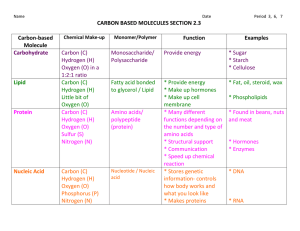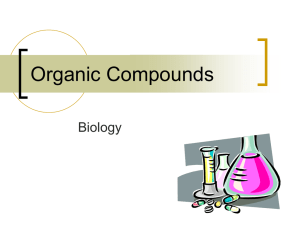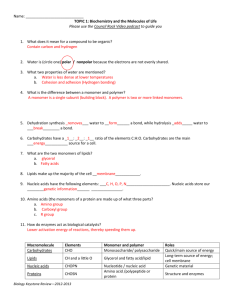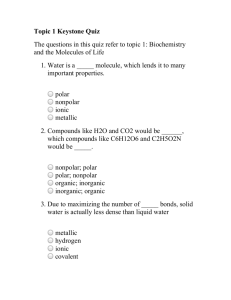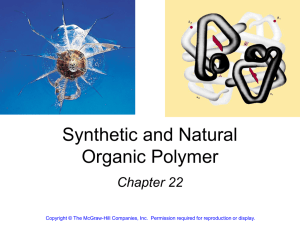Biomolecules Basics: Carbohydrates, Proteins, Lipids, Nucleic Acids
advertisement
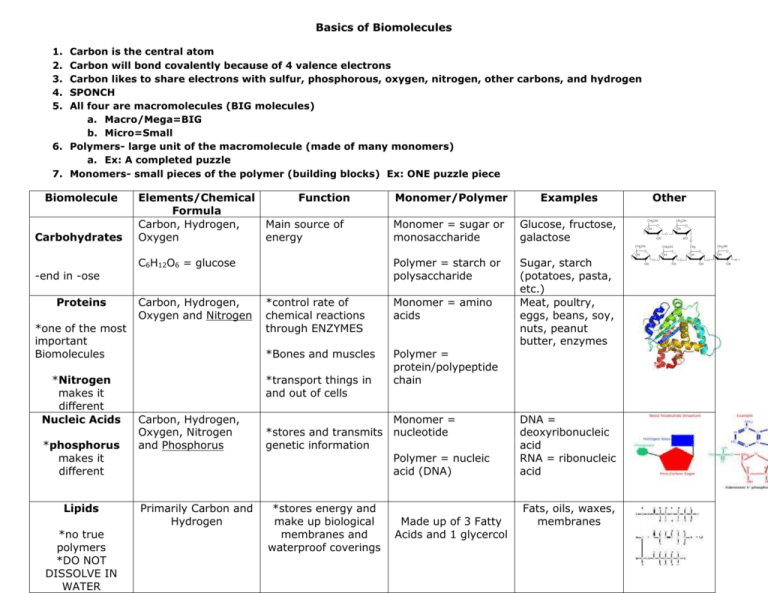
Basics of Biomolecules 1. 2. 3. 4. 5. Carbon is the central atom Carbon will bond covalently because of 4 valence electrons Carbon likes to share electrons with sulfur, phosphorous, oxygen, nitrogen, other carbons, and hydrogen SPONCH All four are macromolecules (BIG molecules) a. Macro/Mega=BIG b. Micro=Small 6. Polymers- large unit of the macromolecule (made of many monomers) a. Ex: A completed puzzle 7. Monomers- small pieces of the polymer (building blocks) Ex: ONE puzzle piece Biomolecule Carbohydrates -end in -ose Proteins Elements/Chemical Function Formula Carbon, Hydrogen, Main source of Oxygen energy C6H12O6 = glucose Carbon, Hydrogen, Oxygen and Nitrogen *one of the most important Biomolecules *Nitrogen makes it different Nucleic Acids *phosphorus makes it different Lipids *no true polymers *DO NOT DISSOLVE IN WATER Monomer/Polymer Examples Monomer = sugar or monosaccharide Glucose, fructose, galactose Polymer = starch or polysaccharide Sugar, starch (potatoes, pasta, etc.) Meat, poultry, eggs, beans, soy, nuts, peanut butter, enzymes *control rate of chemical reactions through ENZYMES Monomer = amino acids *Bones and muscles Polymer = protein/polypeptide chain *transport things in and out of cells Carbon, Hydrogen, Oxygen, Nitrogen and Phosphorus Monomer = *stores and transmits nucleotide genetic information Polymer = nucleic acid (DNA) DNA = deoxyribonucleic acid RNA = ribonucleic acid Primarily Carbon and Hydrogen *stores energy and make up biological membranes and waterproof coverings Fats, oils, waxes, membranes Made up of 3 Fatty Acids and 1 glycercol Other Biomolecule Carbohydrates Elements/Chemical Function Formula Carbon, Hydrogen, Main source of quick Oxygen energy C6H12O6 = glucose Carbon, Hydrogen, Oxygen and Nitrogen Proteins Nucleic Acids Lipids Carbon, Hydrogen, Oxygen, Nitrogen and Phosphorus Primarily Carbon and Hydrogen *control rate of chemical reactions *regulate cell processes *Bones and muscles *transport things in and out of cells Monomer/Polymer Examples Other Monomer = sugar or monosaccharide Glucose, fructose, galactose All end in –ose Polymer = starch or polysaccharide Sugar, starch (potatoes, pasta, etc.) Meat, poultry, eggs, beans, soy, nuts, peanut butter, enzymes Monomer = amino acids Polymer = protein/polypeptide chain Monomer = *stores and transmits nucleotide genetic information Polymer = nucleic acid (DNA) *stores energy and NONE make up biological membranes and waterproof coverings DNA = deoxyribonucleic acid RNA = ribonucleic acid Fats, oils, waxes, membranes *one of the most important biomolecules *Nitrogen makes it different *phosphorus makes it different *not true polymers *DO NOT DISSOLVE IN WATER BIOMOLECULES NOTES 1. Carbon is the ____________ atom 2. Carbon will bond covalently because of 4 valence electrons 3. Carbon likes to share electrons with sulfur, phosphorous, oxygen, nitrogen, other carbons, and hydrogen 4. SPONCH 5. All four are ____________________ (BIG molecules) 6. ______________- large unit of the macromolecule (made of many monomers) 7. Monomers- small ______________ of the polymer (building blocks) Biomolecule Carbohydrates Proteins Nucleic Acids Lipids Elements/Chemical Formula Function Monomer/Polymer Examples Other




